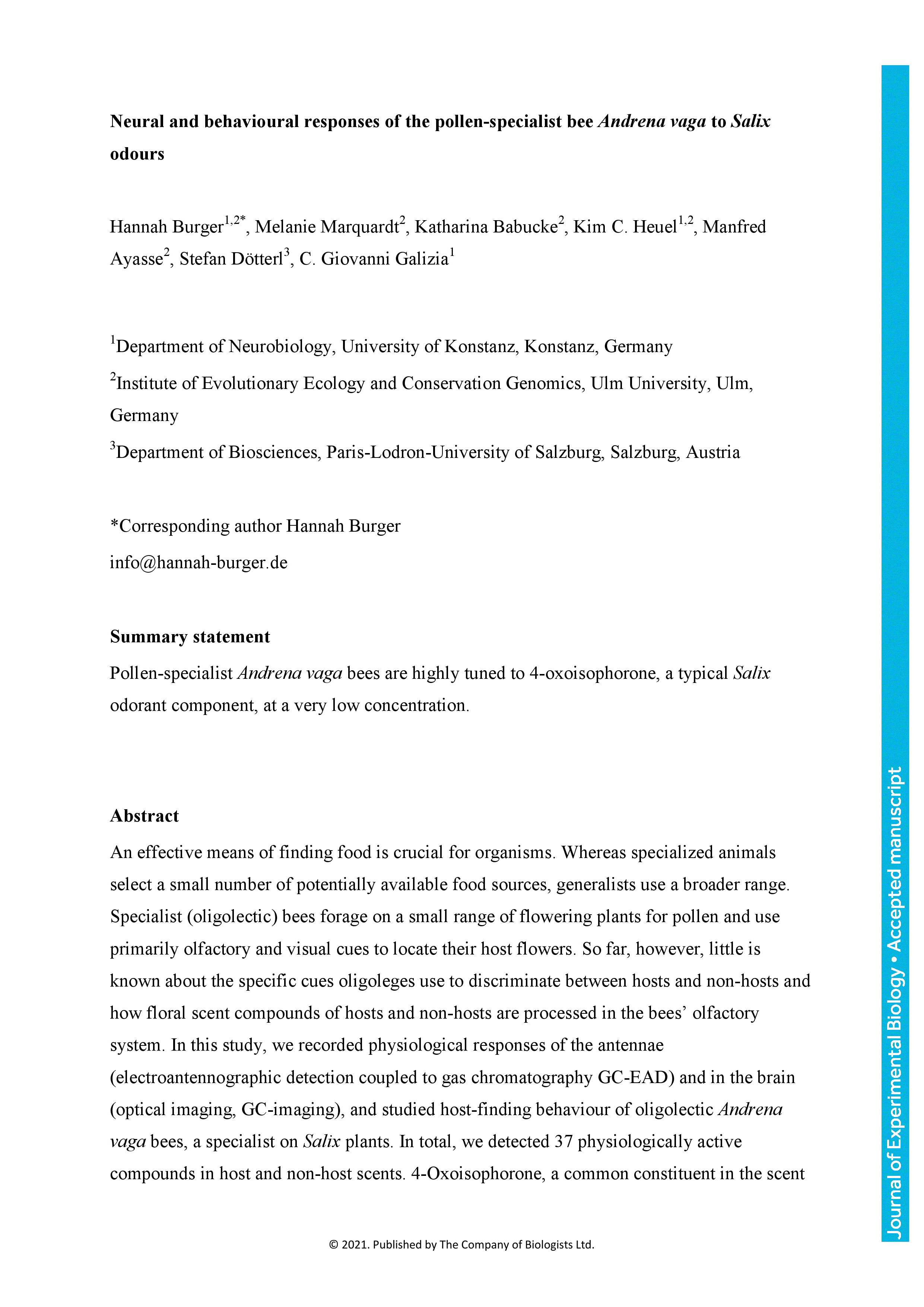An effective means of finding food is crucial for organisms. Whereas specialized animals select a small number of potentially available food sources, generalists use a broader range. Specialist (oligolectic) bees forage on a small range of flowering plants for pollen and use primarily olfactory and visual cues to locate their host flowers. So far, however, little is known about the specific cues oligoleges use to discriminate between hosts and non-hosts and how floral scent compounds of hosts and non-hosts are processed in the bees’ olfactory system. In this study, we recorded physiological responses of the antennae (electroantennographic detection coupled to gas chromatography GC-EAD) and in the brain (optical imaging, GC-imaging), and studied host-finding behaviour of oligolectic Andrena vaga bees, a specialist on Salix plants. In total, we detected 37 physiologically active compounds in host and non-host scents. 4-Oxoisophorone, a common constituent in the scent of many Salix species, evoked strong responses in the antennal lobe glomeruli of A. vaga, but not the generalist honeybee Apis mellifera. The specific glomerular responses to 4-oxoisophorone in natural Salix scents reveals a high degree of specialization in A. vaga for this typical Salix odorant component. In behavioural experiments, we found olfactory cues to be the key attractants for A. vaga to Salix hosts, which are also used to discriminate between hosts and non-hosts, and demonstrated a behavioural activity for 4-oxoisophorone. A high sensitivity to floral scents enables the specialized bees to effectively find flowers and it appears that A. vaga bees are highly tuned to 4-oxoisophorone at a very low concentration.
Neural and behavioural responses of the pollen-specialist bee Andrena vaga to Salix odours
Currently Viewing Accepted Manuscript - Newer Version Available
Hannah Burger, Melanie Marquardt, Katharina Babucke, Kim C. Heuel, Manfred Ayasse, Stefan Dötterl, C. Giovanni Galizia; Neural and behavioural responses of the pollen-specialist bee Andrena vaga to Salix odours. J Exp Biol 2021; jeb.242166. doi: https://doi.org/10.1242/jeb.242166
Download citation file:
Advertisement
2023 JEB Outstanding Paper Prize shortlist and winner

The JEB Editors are delighted to announce the shortlisted authors for the 2023 JEB Outstanding Paper Prize. Read the winning paper - Tiny spies: mosquito antennae are sensitive sensors for eavesdropping on frog calls - by Hoover Pantoja-Sanchez and Brian Leavell from Ximena Bernal's lab at Purdue University, USA.
JEB Science Communication Workshop for ECRs

If you’re an early-career researcher interested in science communication and are attending the SEB Annual Conference in Prague this summer, come a day early and join the JEB Editors at a sci comm workshop to learn the key writing skills needed to promote your research to a broad audience beyond your peers (1 July at 14.30-17.30). Places are limited to 24 attendees, and applicants should apply through the SEB registration page by 30 April 2024.
Bridging the gap between controlled conditions and natural habitats in understanding behaviour

Novel technologies enable behavioural experiments with non-model species, in naturalistic habitats and with underexplored behaviours. In their Commentary, Scholz and colleagues discuss how to obtain a deeper understanding of the natural ecology and lifestyle of study animals.
Beluga metabolic measures could help save species

To help save animals from extinction, it’s important to understand what each species needs to survive. This led Jason John et al. to measure the metabolic rates of captive belugas to develop a ‘fish calculator’ showing that the whales need to eat ~23 salmon per day.
ECR Workshop on Positive Peer Review

Are you an ECR looking for tips on how to write concise, astute and useful manuscript reviews? If so, join the JEB Editors at a 2-hour JEB-sponsored Workshop on Positive Peer Review at the Canadian Society of Zoologists annual meeting in Moncton on 9 May 2024 at 13.00-15.00. There are 25 spaces for ECRs and selection is first come, first serve. To sign up, check the ECR Workshop box when you register for the CSZ meeting.



